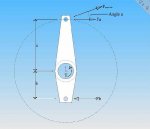Here's the calculations I used to come up with an estimate of the force required to stop a 1250lb weight, dropped from a height of 36 inches, in a distance that is less than the "maximum deflection before yield" of a tube that is 2.00" OD with a .375" Wall Thickness. (All units are/must be in inches, pounds, or seconds) (Force is applied perpendicular to tube at center of span)
Material Properties: (From
www.matweb.com)
Material: 1020 Steel Cold Rolled
Yield Stress (Yield): 50,800 psi
Density: 0.284 lb/in^3 (pounds per cubic inch)
Elasticity Modulus: 29,700,000 psi
Geometry:
Tube OD (OD): 2.00 in
Wall Thickness: 0.375 in
Tube ID (ID): =OD-(2*Wall Thickness) = 1.25 in
Tube Length (L): 48 in
Section Properties:
Max Distance from Neutral Axis (c): =(OD/2) = 1 in
Cross-sectional area: =(pi/4)*(OD^2 - ID^2) = 1.91441 in^2
Second Moment (I): =(pi/64)*(OD^4 - ID^4) = 0.66556 in^4
Section Modulus (Z): = (I/c) = 0.66556 in^3
Force to reach yield stress (F1): =(4*Yield*Z)/L = 2817.52 lbf (pound-force)
Deflection at max stress (ymax): = ((F1)L^3)/(48*E*I) = 0.3284 in
Scenario Properties:
Height of Drop (h): 36 in
Gravity Constant (g): 386.088 in/s^2
Speed at Impact (V): =sqrt(2*g*h) = 166.728 in/s = 13.894 ft/s = 9.473 mph
Weight on corner of truck (lbm (pound-mass)): 1250 lbm
Acceleration (a): =(V^2)/2*ymax) = 42,323 in/s^2 = 2404 mph per second
Calculated Stresses
Force from Drop (F2): = (lbm*a)/g = 137,026 lbf (pound-force)
The reason for the gravitational correction factor in the force equation is because I am using the convention that on Earth, 1 lbf = 1 lbm. This means that a 1250 lbm weight will exert 1250 lbf on whatever it is sitting on. This convention means the standard Force equation (F = ma) is not valid without a correction factor for the gravitational constant. In this case 386.088 in/s^2. This is why I like the metric system. I may not be able to visualize what a Newton is, but I sure know what it does.

Bending Moment (M) (at center of beam): =(F*(L/2))/2 = 1,644,316 in*lbf
Bending Stress (sigma) (at tube surface): = (Mc)/I = 2,470,590 psi (lbf/in^2)
One thing that these equation DO NOT take into account is the actual energy that it takes to bend the link up to and even past yield stress. This would involve dynamic strain-rates and deformation energy. Neither of which I have enough experience in to perform rough calculations. For that, I would recommend a simple finite element analysis. I do currently have access to an FEA program that contains an explicit (capable of performing time-step calculations) solver at work. I am attempting to learn how to test a scenario like this one for my own personal curiosity. If I ever get my two parts to actually make contact instead of passing through each other, I'll let you know.
As a quick look, here's what the link would do with just the weight of the truck on it sitting still:
STATIC Load of Truck on Link:
Force on Link: 1250 lbf
Bending Moment = 15,000 in*lbf
Bending Stress = 22,538 psi
Factor of Safety = 2.254
This means you could STATICALLY apply a force of 2817.5 lbf to it before reaching yield stress. You'll also notice during the course of your calculations that the deflection required to reach yield stress is independent of wall thickness. This is because the maximum bending stress lies on the surface of the tube. Only the force required to reach this deflection changes with wall thickness.
Here's my spreadsheet if you want to play with it. It is "somewhat" user friendly....
View attachment Four Link Calcs(zipped).zip
Any questions? Just ask. I'm starting to have fun now.
















